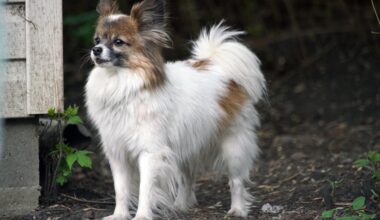The Impact of Age on Stud Dog Fertility and Breeding Success
Understanding the interaction between age and fertility in stud dogs is crucial for breeders. Optimal breeding times are often associated with the dog’s age, particularly when evaluating maturity, health, and overall vitality. Young stud dogs can show a high libido, but it is essential to consider their physical development. Significant factors include their environment and breeding methods employed. A stud dog must reach a level of maturity that allows them to produce healthy, viable sperm. Typically, the male dogs are considered prime for breeding between the ages of two to five years, although some breeds may vary. Addressing nutritional needs and overall health during this crucial period not only enhances fertility but also creates a robust offspring. Furthermore, regular veterinary checkups can help monitor reproductive health and ensure optimal conditions for breeding. As age increases, however, there can be a decline in sperm quality, so monitoring dogs in older age is essential as well. A stud dog aged over seven years can still be viable depending on health and genetics, but it is essential to assess each individual case carefully.
As the dog matures, its fertility status becomes more complex, requiring conscious management by breeders to optimize results. Various hormonal changes can occur as dogs age, impacting not only libido but also the quality and viability of sperm. The decreased fertility in older studs may lead to lower breeding success overall, raising concerns about the likelihood of producing litters. Stud dogs over the age of 7 typically experience changes that could affect their reproductive capabilities, including hormonal fluctuations and potential health issues. These factors can lead to suboptimal sperm counts and motility. Breeders must make informed choices about the timing of breeding sessions, careful scheduling during peak fertility periods can enhance opportunities for success. Additionally, tracking health indicators and stress factors becomes especially relevant in the later years of a stud dog’s life. Regular breeding evaluations can determine the health status and reproductive capacity of older stud dogs. Consequently, breeders should prioritize knowledge of genetics, health histories, and overall limitations when considering older males for breeding. Collaborative assessments with veterinarians can guide decisions, ensuring the best practices are implemented in managing older stud dogs.
Management Practices for Optimal Breeding
To ensure successful breeding, effective management strategies are paramount, especially as stud dogs age. A balanced diet plays a critical role in maintaining reproductive health. Rich in protein, vitamins, and minerals, proper nutrition can enhance sperm quality and dog vitality during breeding. Moreover, age-appropriate exercise regimes should be established to maintain an active and healthy dog in breeding sessions. Regular exercise can improve blood circulation and overall health, essential for reproductive functions. Stress reduction is also essential, as high-stress environments may lead to hormone fluctuations that negatively impact breeding outcomes. This could mean adjusting living conditions or introducing calming practices before breeding seasons. Another vital aspect of management includes routine veterinary checkups, especially as dogs age, to ensure there are no underlying health issues affecting fertility. Testing reproductive health, including semen analysis, can provide insights into the dog’s fertility potential. Additionally, utilizing techniques such as artificial insemination may be considered to provide further options for breeding success, particularly for older or less-lively dogs. Hence, comprehensive management plans targeted at stud dogs at varying ages can enhance breeding outcomes, significantly influencing overall success rates.
The reproductive cycle of a bull and its correlation to stud dog management requires keen observation by breeders. The average stud dog has varying cycles of reproductive viability, which can fluctuate as age advances. Interestingly, many breeders find that the frequency of successful breedings tends to change with the dog’s age and health. Young males often display increased energy and willingness to breed, contributing to higher success rates. A breeding schedule tailored to peak reproductive times is vital to maximize opportunities during optimal cycles. Additionally, breeders should factor in the effects of seasonal changes as some dogs may exhibit seasonal breeding patterns that affect fertility. Environmental factors play a notable role in a dog’s performance, ensuring an environment conducive to breeding can enhance results as well. Understanding the physiological changes that occur with age can also empower breeders to adjust their practices accordingly and seek alternatives when needed. The male dog’s age shouldn’t dictate breeding decisions alone; surrounding health and stress factors must be evaluated continuously. Incorporating flexible management practices aligned with the age and condition can improve the likelihood of successful breeding with continued attention and care.
Evaluating Breeding Success with Age
Measuring breeding success effectively involves examining not just the number of successful matings but also the health of the resulting litters. Older stud dogs often face scrutiny regarding the quality of their offspring due to declining fertility and genetic factors. Breeders should assess the overall condition and vitality of the pups produced through older studs, identifying any potential genetic issues or health concerns. Litters produced from mature dogs can sometimes have mixed results when evaluating overall health and viability, prompting discussions about the implications of advancing age on reproduction. Therefore, effective tracking and evaluation processes emerge as key strategies for breeders. Implementing systems to monitor health records, breeding history, and observable traits in offspring can inform future breeding decisions and behaviors of potential stud candidates, emphasizing the importance of genetic management. Consulting with genetic experts can also uncover underlying trends and inform better choices in pairing. This strategic approach helps ensure that stud dogs, regardless of age, contribute positively to their breeds, maintaining high standards of quality, health, and vitality in both the stud dogs and their descendants.
Another critical factor in successful stud dog management involves understanding the influence of age-related changes on behavior and temperament. Older stud dogs might exhibit different behavior traits compared to their younger counterparts, which can impact breeding performance. It is essential to recognize that temperament plays a significant role in breeding dynamics; for example, younger males may be more eager and responsive during breeding, while older dogs may be more subdued. This shift can alter how a breeding session unfolds, creating diverse experiences for the breeder and the dogs. Taking time to assess both physical and behavioral attributes ensures that appropriate partnerships are formed at the time of breeding. Understanding individual behaviors allows breeders to work with the dog’s strengths, enhancing potential outcomes. Socialization remains critical at all ages, so maintaining good interactions with people and other dogs can help foster positive behavior, impacting overall breeding success. Overall, dog owners must invest time understanding their stud dog’s evolving characteristics as they age. Encouraging active engagement and adaptability ensures breeders can manage stud dogs effectively, leading to successful breeding endeavors.
Conclusion and Final Thoughts
In conclusion, understanding the impact of age on stud dog fertility and breeding success is essential for effective management practices. From physical health to behavioral traits, numerous factors play into breeding success as dogs age. By implementing tailored management plans that address diet, exercise, stress reduction, and veterinary services, breeders can optimize outcomes throughout the dog’s life span. There is no one-size-fits-all approach, as each stud dog, depending on health status and age, may require varied considerations. Regular evaluations and adjustments should be made to ensure the highest standards of breeding success. Additionally, through understanding breed-specific information and genetic factors, breeders are better positioned to make informed decisions when it comes to selecting stud dogs for breeding. Keeping track of both the quality of offspring produced and the health of the stud dog itself can lead to improved practices over time. By actively monitoring age-related changes, breeders can establish hurdles that may arise during the breeding process, aligning their approaches with each unique dog’s needs and circumstances, thus enhancing the overall success within breeding endeavors.
This is another paragraph with exactly 190 words…


